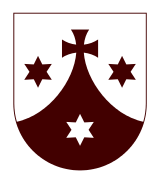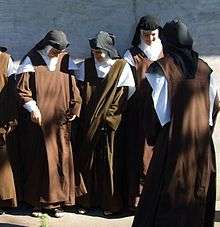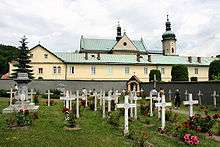Discalced Carmelites
 | |
| Abbreviation | Order of Discalced Carmelites (Ordo Carmelitarum Discalceatorum or O.C.D.) |
|---|---|
| Motto | Zelo zelatus sum pro Domino Deo exercituum (With zeal have I been zealous for the Lord God of hosts) |
| Formation | Late 16th century |
| Type | Roman Catholic religious order |
| Headquarters |
Casa Generalizia dei Carmelitani Scalzi, Rome, Italy |
| Leader | Most Rev. Fr. Saverio (Xavier) of the Sacred Heart of Jesus, O.C.D. |
| Website | www.discalcedcarmel.com |
The Discalced Carmelites or Barefoot Carmelites is a Catholic mendicant order with roots in the eremitic tradition of the Desert Fathers and Mothers. (Discalced is derived from Latin, meaning "without shoes".) The order was established in 1593, pursuant to the reform of the Carmelite Order of the Ancient Observance by two Spanish saints, Saint Teresa of Ávila and Saint John of the Cross.
The Discalced Carmelite order is now known by the initials "O.C.D". The older branch of the order, Carmelites of the Ancient Observance, has the initials "O. Carm." The secular branch of the order (the Secular Order of Discalced Carmelites formerly known as the Third Order), has the initials "O.C.D.S."
Background
The Discalced Carmelites are men and women, in religious consecration and lay people, who dedicate themselves to a life of prayer. The Carmelite nuns live in cloistered (enclosed) monasteries and follow a completely contemplative life. The Carmelite friars while following a contemplative life also engage in the promotion of spirituality through their retreat centres, parishes and churches. Lay people, known as the Secular Order, follow their contemplative call in their everyday activities. Devotion to the Virgin Mary is a characteristic of Carmelites and is symbolised by wearing the brown scapular.[1]
Carmelites trace their roots and their name to Mount Carmel in the Holy Land. There, in the 13th century, a band of European men gathered together to live a simple life of prayer. Their first chapel was dedicated to the Blessed Virgin Mary. They called themselves the Brothers of the Blessed Virgin Mary of Mount Carmel.[2]
The first Carmelites came as pilgrims to Mount Carmel to live a solitary life-style. These early hermits were mostly laity, who lived an unofficial religious life of poverty, penance and prayer. Between 1206 and 1214, St. Albert, Patriarch of Jerusalem, brought the hermits on Mount Carmel together, at their request, into community. He wrote them a formula for living, which expressed their own intention and reflected the spirit of the pilgrimage to the Holy Land and of the early community of Jerusalem. They were also inspired by the prophet Elijah who had been associated with Mount Carmel. That influence can be seen by the words of Elijah, "I have been very zealous for the Lord, God of armies" (IKg 19:10) on the Carmelite crest. Within fifty years of receiving their rule the Carmelite hermits were forced to leave Mount Carmel and settled in Europe.[3]
Founding

A combination of political and social conditions that prevailed in Europe in the fourteenth and fifteenth century- the Hundred Years' War, Black Plague, and rise of the Renaissance and Humanist revival- adversely affected the Order. Although Carmel itself contributed a number of gifted and respected humanists, the trend which started out as a good thing occasioned a general decline in religious fervor. This factor, coupled with the decimation of the population and severe economic hardships, had a demoralizing effect. Many Carmelites and even whole communities succumbed to contemporary attitudes and conditions diametrically opposed to their original vocation. To meet this situation the Rule was "mitigated" several times. Consequently, the Carmelites bore less and less resemblance to the first hermits of Mount Carmel.[4]
St. Teresa of Avila considered the surest way to prayer to be a return to the Primitive Rule embodying Carmel's authentic vocation. A group of nuns assembled in her cell one September evening in 1560, taking their inspiration from the primitive tradition of Carmel and the discalced reform of St. Peter of Alcantara, a controversial movement within Spanish Franciscanism, proposed the foundation of a monastery of an eremitical kind.
With little resources and often bitter opposition, St. Teresa succeeded in 1562 in establishing a small monastery with the austerity of desert solitude within the heart of the city of Ávila, Spain, combining eremitical and community life. On 24 August 1562, the new Convent of St. Joseph was founded. Her rule, which retained a distinctively Marian character, contained exacting prescriptions for a life of continual prayer, safeguarded by strict enclosure and sustained by the asceticism of solitude, manual labor, perpetual abstinence, fasting, and fraternal charity. In addition to this, St. Teresa envisioned an order fully dedicated to poverty.[4]
Working in close collaboration with St. Teresa was St. John of the Cross, who with Anthony of Jesus founded the first convent of Discalced Carmelite friars in Duruelo, Spain on 28 November 1568.[5]
The Discalced Carmelites were established as a separate province of the Carmelite Order by the decree "Pia consideratione"[6] of Pope Gregory XIII on 22 June 1580. By this decree the Discalced Carmelites were still subject to the Prior General of the Carmelite Order in Rome, but were otherwise distinct from the Carmelites in that they could elect their own superiors and author their own constitutions for their common life. The following Discalced Carmelite Chapter at Alcala de Henares, Spain in March 1581 established the constitutions of the Discalced Carmelites and elected the first provincial of the Discalced Carmelites, Fr. Jerome Gratian, OCD. This office was later translated into that of Superior General of the Discalced Carmelites.[7]
The Carmelite charism

According to the Irish Province of the Order of Carmelites,[8] with regard to a religious order, the term charism refers to a characteristic which inspires the group and distinguishes it from other religious orders. The charism of each Christian religious family is the particular way in which its members are called to follow Christ. Since all Christians follow Christ, the charisms will have many elements in common, but the way in which these elements are emphasised gives each religious group its unique feel.
The heart of the Carmelite charism is prayer and contemplation. The quality of prayer determines the quality of the community life and the quality of the service which is offered to others. Prayer and contemplation for the Carmelite are not private matters between the individual and God but are to be shared with others since the charism is given for the whole world. Therefore, there is an emphasis in the order on the ministry of teaching prayer and giving spiritual direction.[8]
For a Carmelite, prayer is guided by the teachings and experience of St. Teresa of Ávila and St. John of the Cross, as well as the saints who have followed in their steps, such as St. Thérèse of the Child Jesus and of the Holy Face, Saint Elizabeth of the Trinity, St. Teresa of the Andes, and martyrs like Edith Stein (St. Teresa Benedicta of the Cross), Père Jacques and the sixteen Martyrs of Compiegne.
Fraternity, service and contemplation are essential values for all Carmelites. The hermits were forced to leave their home on Mount Carmel and settle in Europe. There they changed their style of life from hermits to friars. The major difference is that friars are called to serve the People of God in some active apostolate. Some congregations were founded for a specific work, but the Carmelite Order tries to respond to what it sees as the needs of the Church and the world which differ according to time and place, and so many friars work in parishes, schools, universities, retreat centres, prisons and hospitals. The kind of service in which each individual friar is involved will depend on the perceived needs of the people in whose midst he lives and his own particular talents.[8]
Each day is marked by silence for prayer. In addition to the daily celebration of the full Liturgy of the Hours, two hours are set aside for uninterrupted silent prayer. Communities are kept fairly small. The friars practice a broadly-based discipline of study.
Bishops
Living bishops (4 archbishops, 16 bishops)
| |
Former and actual episcopal see or assignment | Current residency | Date of birth current age |
Appointed to episcopacy |
|---|---|---|---|---|
| Anders Arborelius | (1998–Incumbent)
|
|
September 24, 1949 | November 17, 1998 Pope John Paul II |
| Cástor Oswaldo Azuaje Pérez | (2012–Incumbent)
|
|
October 19, 1951 | June 30, 2007 Pope Benedict XVI |
| Silvio José Báez Ortega | (2009–Incumbent) |
|
April 28, 1958 | April 9, 2009 Pope Benedict XVI |
| Philip Boyce | (1995–Incumbent) |
|
January 25, 1940 | June 29, 1995 Pope John Paul II |
| Peter Chung Soon-taek | (2013–Incumbent) |
|
August 2, 1961 | December 30, 2013 Pope Francis |
| Paul Dahdah | (1999–Incumbent)
|
|
June 8, 1941 | May 30, 1983 Pope John Paul II |
| Brig. Gen. Gonzalo de Jesús María del Castillo Crespo | (2012–Incumbent)
|
|
September 20, 1936 | November 3, 1983 Pope John Paul II |
| Amancio Escapa Aparicio | (1996–Incumbent) |
|
March 30, 1938 | May 31, 1996 Pope John Paul II |
| Guy Étienne Germain Gaucher | (2005–Incumbent)
|
|
March 5, 1930 | August 27, 1986 Pope John Paul II |
| Gustavo Girón Higuita | (1999–Incumbent)
|
|
May 20, 1940 | February 8, 1990 Pope John Paul II |
| Gonzalo López Marañon | (2010–Incumbent)
|
|
October 3, 1933 | July 2, 1984 Pope John Paul II |
| Luis Alberto Luna Tobar | (2000–Incumbent)
|
|
December 15, 1923 | August 17, 1977 Pope Paul VI |
| Francis George Adeodatus Micallef | (2005–Incumbent)
|
|
December 17, 1928 | November 5, 1981 Pope John Paul II |
| Aníbal Nieto Guerra | (2009–Incumbent)
|
|
February 23, 1949 | June 10, 2006 Pope Benedict XVI |
| Marie Fabien Raharilamboniaina | (2010–Incumbent) |
|
January 20, 1968 | February 26, 2010 Pope Benedict XVI |
| Braulio Sáez Garcia | (2003–Incumbent)
|
|
March 23, 1942 | February 18, 1987 Pope John Paul II |
| Rubens Sevilha | (2011–Incumbent) |
|
September 29, 1959 | December 21, 1987 Pope Benedict XVI |
| Jean Benjamin Sleiman | (2001–Incumbent) |
|
June 30, 1946 | November 29, 2000 Pope John Paul II |
| Jusztin Nándor Takács | (2003–Incumbent)
|
|
January 15, 1927 | December 23, 1988 Pope John Paul II |
| Rolando Joven Tria Tirona | (2012–Incumbent)
|
|
July 22, 1946 | November 15, 1994 Pope John Paul II |
Dead bishops (7 cardinals, 14 archbishops, 52 bishops)
Communities of Carmelite tradition
- Byzantine Discalced Carmelites
- Carmelites of Mary Immaculate
- Carmelites of the Ancient Observance
- Hermits of the Most Blessed Virgin Mary of Mount Carmel
- Monks of the Most Blessed Virgin Mary of Mount Carmel
- Secular Order of Discalced Carmelites
- Sisters of the Apostolic Carmel
- Third Order of Our Lady of Mount Carmel
- Episcopal Carmel of Saint Teresa
See also
- Book of the First Monks
- Carmelite Rule of St. Albert
- Constitutions of the Carmelite Order
- Monastery of Mary, Mother of Grace
- St. Raphael Kalinowski
- Jan Tyranowski
References
- ↑ "Who are the Discalced Carmelites?". Discalcedcarmelites.ie. Archived from the original on September 1, 2013. Retrieved 2013-11-29.
- ↑ "History", Discalced Carmelite Friars of the Carmelite-Arizona Province
- ↑ "Hermits on Mount Carmel". Carmelite.com. Retrieved 2013-11-29.
- 1 2 ocd. "Carmelite History -from the OCD General House in Rome". Ocd.pcn.net. Retrieved 2013-11-29.
- ↑ "History of Discalced Carmelites", Generalate of the Teresian Carmel
- ↑ Otilio Rodriguez, OCD, Appendix I: The Third Order of the Teresian Carmel; Its Origin and History, page 129, in Michael D. Griffin, OCD, Commentary on the Rule of Life (superseded) (The Growth in Carmel Series; Hubertus, Wisconsin: Teresian Charism Press, 1981), pages 127-36
- ↑ Peter-Thomas Rohrbach, OCDJourney to Carith: The Sources and Story of the Discalced Carmelites, Chapter 6: The Struggle for Existence, pages 200-1 (Washington: ICS Publications)
- 1 2 3 The Carmelite Charism -from the Irish Province Archived July 30, 2012, at the Wayback Machine.
External links
| Wikimedia Commons has media related to Discalced Carmelites. |
- Official website
- No Greater Love, a 2009 documentary about the nuns at the monastery of the Most Holy Trinity, in London’s Notting Hill

